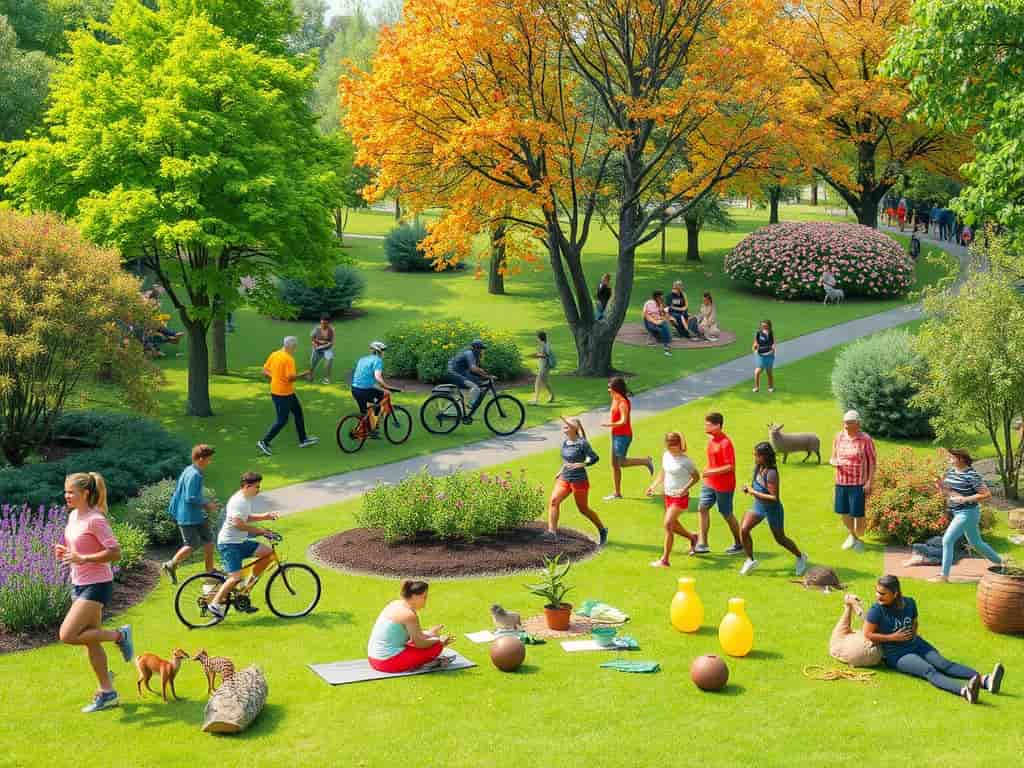Exercise can have a significant impact on environmental health in many positive ways. By choosing active forms of transportation such as walking, cycling, or running instead of driving, you help reduce the amount of harmful emissions released into the air. These simple activities can lower pollution levels, contributing to cleaner air for everyone.
Additionally, outdoor exercises encourage the preservation of green spaces and natural habitats, supporting biodiversity. As more people engage in eco-friendly exercise routines, it creates a ripple effect, inspiring others to make healthier choices for both their well-being and the planet. This way, exercise becomes an important tool not only for personal fitness but also for maintaining a healthier environment.
How Does Exercise Reduce Carbon Emissions?
Exercise helps lower carbon emissions in practical ways. People avoid using cars by choosing active transportation methods such as walking, cycling, or skateboarding, which emit harmful greenhouse gases. This shift supports cleaner air and healthier communities. Additionally, using bikes or walking paths reduces traffic congestion, which also helps minimise air pollution.

When more people adopt active transportation, cities become more pedestrian-friendly, encouraging others to do the same. Over time, this lifestyle change can significantly reduce urban areas’ overall carbon footprint, contributing to a more sustainable environment.
Why Is Outdoor Exercise Better For The Environment?
Outdoor exercise is an eco-friendly choice because it avoids the energy use associated with gym equipment. By stepping outside, you reduce electricity consumption while enjoying the fresh air. This saves resources and minimizes the environmental impact of fitness activities. Additionally, spending time in nature can inspire excellent environmental care and promote sustainable habits.
It’s a simple way to care for your health while contributing to a healthier planet. Plus, outdoor exercise encourages the preservation of green spaces and reduces the demand for resource-intensive fitness facilities—every step you take outdoors benefits both you and the Earth.
What Are The Components Of Health, And How Do They Relate To Wellness?
Health components include physical, mental, emotional, social, and environmental well-being. These aspects are interconnected, as maintaining good physical health often boosts emotional and mental wellness, while positive environmental health can enhance the quality of life and social interactions.
Additionally, a strong social support system helps reduce stress and improves mental health. When we care for our environment, we also create spaces that promote social bonding and physical activity. Ultimately, balancing all these components leads to overall wellness, where every part contributes to a healthier and more fulfilling life.
Exercising Outdoors – A Win for You and the Environment!
Picture a world filled with clean air, lush greenery, and thriving wildlife. Now, imagine yourself feeling stronger, healthier, and more energized. Believe it or not, these two are closely linked. Exercise isn’t just about improving personal fitness—it also plays a role in protecting the environment.
By making small, mindful choices, we can reduce our impact on the planet while staying active:
- Walking or biking instead of driving helps cut down on harmful emissions and keeps the air cleaner.
- Exercising outside reduces the need for electricity-powered gym machines, saving energy.
- Using reusable water bottles instead of plastic ones keeps unnecessary waste out of landfills and oceans.
Every little effort counts. By combining fitness with eco-friendly habits, we contribute to a healthier planet while also taking care of ourselves.
Also read: What Insurance Does Corewell Health Accept – Don’t Miss These Details!
The Many Benefits of Outdoor Exercise:
Choosing to work out outside offers so much more than just fresh air. It improves overall well-being and strengthens our bond with nature. Let’s take a closer look at some of the benefits:
- Boosts Mood – Spending time in nature increases serotonin levels, which can help lift your spirits and reduce stress. For teens, having access to support, such as teen online therapy, can also provide helpful tools for managing anxiety and mental health challenges.
- Provides Essential Vitamin D – Sunlight naturally gives us vitamin D, which is important for strong bones and a healthy immune system.
- Saves Money – No need for a gym membership—outdoor workouts, like running, hiking, or bodyweight exercises, are completely free!
- Reduces Your Carbon Footprint – Choosing outdoor activities over driving or using electricity-powered gym equipment helps minimize environmental impact.
Fitness Strengthens Environmental Awareness:
When people spend more time outdoors, they often become more aware of nature’s beauty and the need to protect it. Here’s how being active outside can encourage environmental responsibility:
- People who regularly exercise in parks or trails tend to develop a greater appreciation for green spaces and are more likely to support conservation efforts.
- Many fitness enthusiasts take part in community clean-ups or tree-planting initiatives to help maintain outdoor areas.
- Some environmental projects require physical effort, such as building hiking trails or restoring natural habitats—tasks that are easier with a fit and active community.
How Fitness Choices Can Save Energy and Protect the Planet?
Exercise isn’t just about personal health—it’s also a great way to reduce energy consumption. Here’s how simple fitness choices can help the environment:
- Walking or cycling instead of using a car reduces air pollution and fossil fuel use.
- Exercising outdoors eliminates the need for treadmills and other machines that consume electricity.
- Choosing eco-friendly workout gear, like reusable water bottles and sustainable clothing, helps minimize waste.
By making conscious choices, we can protect the environment while staying active and healthy. When fitness and sustainability go hand in hand, both our bodies and our planet thrive!
Also read: How To Become A Mental Health Volunteer In Baytown – Tips & Requirements!
Reducing Carbon Footprint Through Active Transportation:
Walking And Cycling:
Switching from driving to walking or cycling is a small change that makes a big impact. These eco-friendly transportation options reduce greenhouse gas emissions, promoting cleaner air for everyone. Along with benefiting the environment, walking and cycling also improve cardiovascular health, making them a smart choice for overall well-being.
Skateboarding And Rollerblading:
Using non-motorized modes of transportation, like skateboarding or rollerblading, adds variety to active commuting while reducing reliance on fossil fuels. These alternatives are not only fun but also practical for short-distance travel or recreation. By opting for these methods, individuals can contribute to sustainable living while enjoying their daily activities.
How Exercise Can Positively Affect Your Environmental Health:

- Reduces Carbon Emissions: Choosing walking, cycling, or other active modes of transportation reduces reliance on vehicles. This shift decreases greenhouse gas emissions, lowers air pollution, and improves air quality. It’s an effective way to contribute to a healthier environment while staying physically active.
- Supports Green Space Preservation: Outdoor exercise creates demand for parks, trails, and other green areas. Communities often work to maintain and expand these spaces, which benefit both physical health and the environment by preserving ecosystems and improving biodiversity in urban settings.
- Lowers Energy Consumption: Exercising outdoors reduces the need for energy-consuming gym equipment. By avoiding machines powered by electricity, individuals can conserve energy while still enjoying effective workouts. This simple choice promotes sustainability and lessens environmental impact.
- Raises Environmental Awareness: Spending time outdoors for exercise helps people connect with nature. This connection encourages individuals to care more about environmental issues, adopt sustainable habits, and support efforts to protect natural resources for future generations.
- Encourages Community Sustainability: Group exercises, such as park runs or fitness events, often involve eco-friendly initiatives like clean-ups or tree planting. These activities build stronger communities while promoting a shared commitment to environmental sustainability and collective well-being.
Enhancing Environmental Awareness Through Nature Exposure Appreciation For Ecosystems:
Engaging in outdoor exercise offers a unique opportunity to connect with nature, which can lead to a stronger appreciation for ecosystems. As people experience the beauty of forests, parks, or beaches, they develop a more profound respect for wildlife and biodiversity. This connection often sparks a desire to protect these natural spaces.
Moreover, outdoor activities like hiking or trail running can inspire individuals to adopt pro-environmental behaviors. As they enjoy nature’s beauty, they may feel motivated to reduce their carbon footprint, recycle more, or minimize plastic waste. These small actions can collectively have a significant impact on preserving the environment.
How Can Communities Combine Fitness With Environmental Action?
Fitness groups can play a key role in environmental action by organizing clean-up events. These events allow participants to engage in physical exercise while making a positive impact on the community. By cleaning up local parks, beaches, or streets, they directly improve the surrounding environment.
Additionally, such initiatives help raise awareness about waste reduction and recycling. It also brings people together, fostering a sense of shared responsibility for both health and the planet. Through these efforts, communities can combine fitness with environmental action, leading to a healthier, cleaner, and more connected space for everyone.
How Do Green Spaces Benefit From Exercise?

Promoting The Creation Of Green Spaces:
Outdoor exercise increases the demand for accessible parks and recreational areas. As more people engage in physical activities like jogging, cycling, and yoga, communities recognize the need for these spaces. This creates a positive cycle where the demand for green areas leads to their development and preservation.
Supporting Urban Sustainability:
With more people using green spaces for exercise, cities become more invested in maintaining these areas. The focus shifts towards creating sustainable, eco-friendly urban environments that offer recreational options while reducing pollution. As a result, urban sustainability improves, benefiting both residents and the environment.
Enhancing Biodiversity:
Exercise in natural areas often brings attention to the importance of biodiversity. When people see wildlife thriving in parks and green spaces, they are more likely to support efforts to protect these ecosystems. The presence of healthy wildlife and plants encourages conservation practices and strengthens the connection between people and nature.
Reducing Urban Heat Island Effect:
Green spaces also help combat the urban heat island effect, which makes cities significantly hotter than surrounding rural areas. When more people engage in outdoor activities, it promotes the planting of trees and the development of green roofs, which help cool down the environment and improve overall air quality.
Strengthening Community Engagement:
Outdoor exercise brings communities together, encouraging shared use of parks, walking trails, and other public spaces. This sense of connection fosters a collective responsibility for protecting and caring for these areas. As a result, individuals feel more invested in maintaining the health of their local environment.
Also read: How Does Social Media Affect Mental Health And Gpa – What You Need To Know!
Why Is Exercise Important For Good Physical Fitness?
Exercise is crucial for physical fitness because it strengthens the body, improves cardiovascular health, enhances endurance, and helps maintain a healthy weight. It also boosts the immune system, reduces the risk of chronic diseases, and improves overall well-being. In addition, regular physical activity helps increase flexibility and balance, which is essential for preventing injuries.
it promotes better sleep and mental clarity, making you feel more energized throughout the day. Furthermore, consistent exercise can improve your posture, reducing strain on muscles and joints. It can also increase your self-confidence as you see progress in your physical abilities. Ultimately, exercise contributes to a higher quality of life by promoting both physical and mental health.
What is the Difference between physical activity and exercise?
| Aspect | Physical Activity | Exercise |
| Definition | Any movement of the body that uses energy, like walking or gardening. | Planned, structured activity designed to improve or maintain physical fitness, like running or weight training. |
| Purpose | To complete daily tasks and activities. | To improve or maintain fitness levels, strength, and health. |
| Intensity | Generally low to moderate intensity. | Typically higher intensity, aimed at challenging the body. |
| Frequency | Occurs naturally throughout the day without planning. | Done on a regular, scheduled basis as part of a fitness plan. |
| Examples | Walking, cleaning, gardening, or taking the stairs. | Running, cycling, swimming, weightlifting, or yoga. |
How Can Exercise Positively Impact Environmental Health?
Exercise can positively impact environmental health by promoting sustainable transportation, like walking or cycling instead of driving. These activities reduce carbon footprints and minimize pollution, leading to cleaner air and a healthier planet. Additionally, outdoor exercises in green spaces help protect natural ecosystems by encouraging their maintenance and preservation.
Engaging in eco-friendly fitness activities also raises awareness about environmental issues, inspiring people to adopt greener habits. In the long run, regular outdoor physical activity can foster a deeper connection to nature, encouraging communities to value and protect the environment for future generations.
FAQS:
How does walking contribute to environmental health?
Walking reduces the need for driving, which lowers greenhouse gas emissions. It also minimizes traffic congestion, resulting in less pollution and healthier air quality, making it an environmentally friendly choice for short trips.
What role do cycling and running play in environmental health?
Cycling and running are eco-friendly exercises that don’t require fuel or electricity, reducing carbon emissions. They also promote cleaner air by lowering the use of motor vehicles, helping preserve the environment and improve public health.
Can outdoor exercise help combat climate change?
Yes, outdoor exercises like hiking, walking, or cycling can reduce carbon footprints and lessen reliance on fossil fuels. These activities contribute to a decrease in pollution, supporting global efforts to mitigate climate change and promote sustainability.
How does using green spaces for exercise benefit the environment?
Exercising in green spaces such as parks or nature reserves helps promote their preservation. By using these spaces, we encourage the local government to protect and maintain these areas, which are vital for biodiversity and overall environmental health.
What are the environmental benefits of exercising without equipment?
Exercising without equipment, such as bodyweight exercises or yoga, reduces the demand for manufacturing and transportation of gym gear. This lessens resource consumption and waste, contributing to a more sustainable and eco-friendly fitness routine.
Conclusion:
Exercise not only benefits individual health but also plays a crucial role in improving environmental health. By adopting active transportation like walking and cycling, individuals help reduce carbon emissions, minimize pollution, and promote cleaner air. Outdoor exercises foster the preservation of green spaces and biodiversity, while raising awareness about sustainability.
These actions collectively contribute to a more eco-friendly lifestyle, benefiting both personal well-being and the planet. Exercise offers a simple yet effective way to enhance physical fitness while positively impacting the environment for future generations.
Related post:











